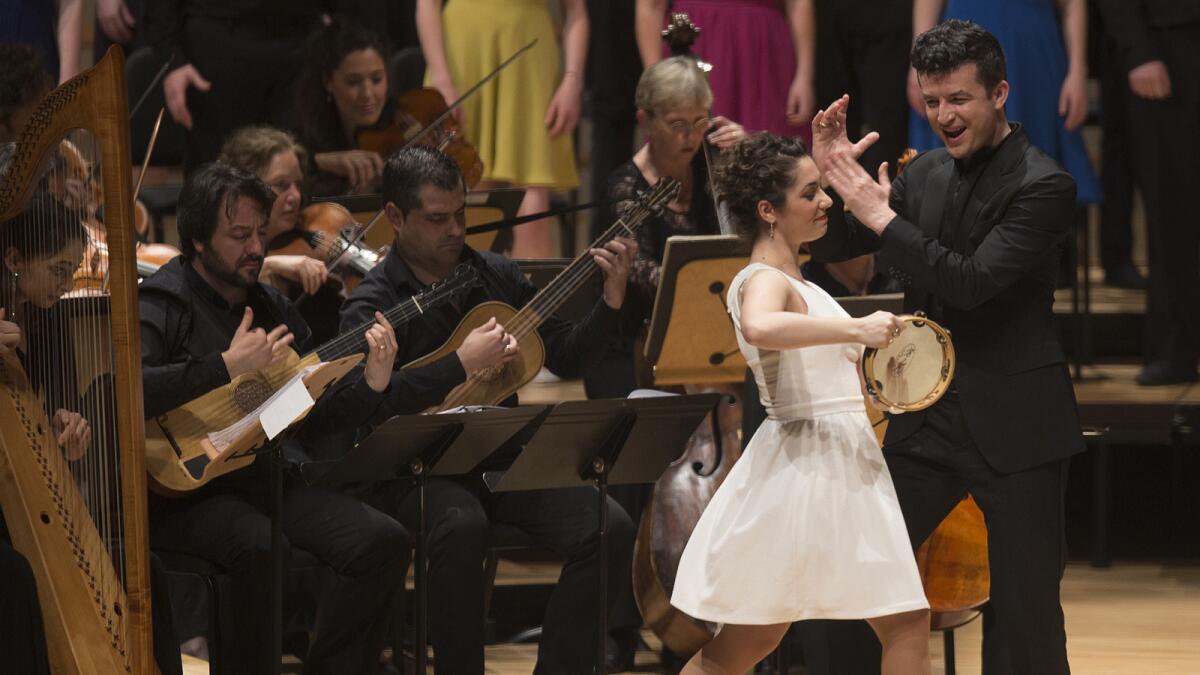Monteverdi’s ‘L’Orfeo,’ the first modern opera, has lessons for digital age

Francesca Aspromonte and Krystian Adam perform at Segerstrom.
- Share via
The myth that opera was born of a miracle dies hard. Musicologists no longer insist that what has proved to be a uniquely innovative art form for four centuries was the exclusive product of scholars in Florence, Italy, who sought authentic reenactment of ancient Greek theater. Today we link opera to a variety of experiments combining music and spectacle throughout the Middle Ages and Renaissance.
But this much is true. It took less than a decade for the anachronistic Florentine proposals to be turned into a revolutionary work of music theater.
Monteverdi’s “L’Orfeo,” which had its premiere in Mantua in 1607 and which came across as still stunningly vital at the Renée and Henry Segerstrom Concert Hall on Saturday night, is the first modern opera. The spectacular performance was part of a touring program by John Eliot Gardiner’s English Baroque Soloists and Monteverdi Choir, which also performed Monteverdi’s “Vespers of 1610.”
Moreover, when looked at in a context that included USC Opera’s weekend production of Gluck’s wondrously poised “Iphigénie en Tauride” and Los Angeles Opera’s goofy “Hercules Vs. Vampires,” Gardiner’s Monteverdi in Costa Mesa revealed an angle to the history of opera that is relevant to the dizzy digital world we are all trying to make sense of.
Opera may have had antecedents, but they typically lacked the seriousness, depth or emotional punch of Greek drama. The Florentines recognized that music theater needed to focus again on essentials. The first attempts were small scale and anachronistically stilted.
But Monteverdi happened to be one of music’s most inventive reformers. He put everything he knew as a composer of madrigals and as a church composer into the creation of a new kind of narrative art form that told a story from within the minds of characters.
Gardiner came equipped with a large orchestra of extravagant period instruments, including four chitarrone, which are lutes with dramatically long necks. But the celebrated British conductor made sure the forceful performances spoke to a 21st century audience. He employed impressively large voices, as though bred for grand halls like Segerstrom.
What became obvious in these terrific performances was that the urge for theater in Monteverdi was a refinement of sentiment from a wide variety of sources. Orfeo’s quest to bring back Eurydice from the dead begins as a lover’s lament but ends up a spiritual pursuit.
In the vespers, Monteverdi allowed excessive sensuality of religious devotion an erotic component. It is no coincidence that “Orfeo” and the vespers open with the same brass fanfare. For Monteverdi the church was theater and theater a sacred space.
The singers were terrific, especially the dapper Krystian Adam (Orfeo), the multifaceted Francesca Aspromonte (Music, Hope and Eurydice) and the booming Gianluca Buratto (Caron and Pluto). In the monumental vespers, the chorus (aided by the Los Angeles Children’s Chorus) and the orchestra made a mighty impression. All the spaces in Segerstrom that could be used were used with nothing but success.
Monteverdi’s great contribution to music was this ability to aim a wealth of riches toward a fixed dramatic goal. But riches have a way, as we witness daily in the Internet age, of attracting an overdose of hard-sell gimmickry. A reboot was necessary for it to become viable for a new Classical age.
Gluck was that great reformer, most famously returning drama to its eloquent personalized essence with the help of the Orpheus myth. In “Iphigénie,” Gluck excels in sublime balance by pairing down Euripides’ play to its fundamentals and setting restrained musical parameters against which emotional imbalance can be best recognized.
The USC production by Ken Cazan brought some of the underlying violence to the surface but without compromising the refined beauty of Gluck’s near-perfect score. At the Sunday matinee, the last of four double-cast performances in Bing Theatre, Yelena Dyachek was a commanding Iphigenia and David Castillo an impassioned Orestes.
Greek drama still inspires. Over the weekend, La Monnaie, the Brussels opera company, streamed its latest new opera, a majestically fierce production of Pascal Dusapin’s modernist “Penthesilea,” and the latest use of the Trojan War as a vehicle to express the angst of conquest. It can still be seen on Belgian radio station RTBF’s classical website, Musiq34.
The L.A. Opera effort to appropriate ancient Greece was trivial in comparison. Here, a slight opera score performed as a new soundtrack for a desiccated print of an Italian exploitation film. But Patrick Morganelli’s opera did remind us of the latest major effort at operatic reform.
By the 1970s, opera had once again come to seem an inchoate and irrelevant art form. In “Einstein on the Beach,” Philip Glass and Robert Wilson began with a blank operatic slate while embracing the technology available in an opera house. It was the start of endless Glass innovations, which included the technique of combining opera with film and beginning with — what else? — “Orphée.”
As we become increasingly distracted, encouraged as we are in all aspects of life to contribute to the glut the Internet offers, opera and its cycle of reforms take on new importance. It is an art form inspired by the past that has proved essential to the future.
Not only the classical arts, but film, popular music and much else in what we consider entertainment today would not be the way we know them today had it not been for opera’s revolutionary reforms, for the advances in both musical procedures and theatrical approaches that came about by overcoming the needless and enhancing the necessary.
More to Read
The biggest entertainment stories
Get our big stories about Hollywood, film, television, music, arts, culture and more right in your inbox as soon as they publish.
You may occasionally receive promotional content from the Los Angeles Times.











